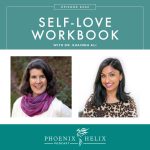From Gluten-Free Girl to Joy Advocate
You may know Shauna Ahern as The Gluten-Free Girl, the award-winning blog she wrote for over a decade, which led to 3 bestselling cookbooks and a memoir of the same name. Now, her life and career have gone in a different direction. After experiencing a medical crisis brought on by stress, she looked at her life through a joy lens, removing stressors and adding more pleasure and peace. Now, it’s her mission to help others do the same. The truth is, it’s often easier to find joy when life is going well, but what if you’re in the middle of an autoimmune flare? What if you’re struggling with depression or anxiety? What if you’re in the middle of a life crisis? Is joy something we can cultivate even during our most difficult times? And what are the benefits if we learn how? These are the questions we’ll be exploring in our conversation today.
Listen to the Show
- Subscribe to my podcast through your favorite podcast app: iTunes, Stitcher, Google, TuneIn, Spotify, Amazon, etc.
- You can also listen to the episode right here through the player below, and if you subscribe to my newsletter you’ll get notified of future episodes.
Podcast: Play in new window | Download
Show Notes
- Intro (0:00)
- Thank You to Our Podcast Sponsor – Autoimmune Strong (2:48)
- Have you heard of Autoimmune Strong yet? It’s the ONLY exercise program designed FOR people living with chronic pain, BY someone living with chronic pain.
- Andrea Wool, the personal trainer behind Autoimmune Strong, is an autoimmune warrior herself. She struggled for years trying to figure out how to exercise in a way that made her feel good, but all the fitness programs she tried ended up causing flare-ups and exhaustion instead. She knew there had to be a better way. So she studied, experimented, and created a program that works FOR people with autoimmune disease.
- The goal of Autoimmune Strong is to help you gain strength, flexibility, and mobility, without causing exercise induced flare-ups or post-exercise exhaustion.
- All the exercises can be done at home – no gym necessary. And there is a ton of support built in all along the way, with access to expert coaches, monthly zoom calls with Andrea, and an amazing membership community filled with other people just like you.
- You can try Autoimmune Strong for free! Everyone gets a 7-day free trial. Andrea is also giving my listeners an extra discount of 10% off your first month with the code PHOENIX.
- We all deserve to feel healthy and strong in our bodies. You deserve a life with fewer flares and more joy. Learn more at GetAutoimmuneStrong.com.
- Meet Shauna (4:41)
- Shauna Ahern had health issues throughout her life. She got sick frequently, catching every cold that came through. She had frequent abdominal crises that no one could figure out. She had pneumonia multiple times. This was her “normal”.
- Her rock bottom happened in 2004. She had a bad flu that didn’t go away and developed severe abdominal pain, headaches, and insomnia. She also lost her taste for food which shocked her more than anything else, because she had always been a foodie. She went to multiple doctors who could find nothing wrong. She went to the emergency room multiple times and honestly thought she was dying. They ran every expensive test imaginable: MRI, cat scan, colonoscopy, endoscopy. But they never tested her for celiac disease. At the time, it was the most underdiagnosed disease in America.
- Finally, she heard an NPR news story about celiac, and everything clicked – her body knew. Unfortunately, when she asked her gastroenterologist for a simple celiac blood test, he refused, so she went to another doctor who agreed to the test. The results were positive. Unlike many patients, she didn’t grieve the diagnosis. She celebrated it. It was such a relief to finally know what was wrong and have a path to feeling better.
- Gluten-Free Girl (10:09)
- She started sharing her gluten-free journey with family and friends via email, but her brother suggested she start a blog. She was truly surprised when a community developed around it. It was the first gluten-free blog in the world and soon became a phenomenon. It was a huge source of joy for her for the first 4-6 years. She loved writing, she loved writing about food, she loved helping people. She also met her husband through her blog (he is a chef). Soon, they got a cookbook deal. It was a dream! Until it wasn’t.
- Eventually, the pressure to make a living from the blog had her focusing on business and branding instead of joy. A huge gap developed between Gluten-Free Girl (her brand) vs. challenges in her real life she didn’t feel she could share publicly. This tapped into childhood trauma where she was also forced to pretend, and she was miserable, but it never occurred to her that she could stop. In 2015, her body was the one to make the decision to stop.
- One day, in the middle of a business meeting, she had a ministroke. It included all the symptoms of a stroke including the inability to talk which was terrifying. She was admitted to the hospital, and thankfully her symptoms resolved on their own. Afterward, her doctor told her that all her tests had come back normal – there was nothing physically wrong. He explained that emotional stress can cause physical damage. It was a huge wake-up call. Her doctor encouraged to make a list of everything stressful in her life and figure out how to let those things go. That’s what she did, and that was the end of Gluten-Free Girl. The journey is documented in her memoir, Enough.
- Now, Joy is the focus of her life both personally and professionally. She doesn’t do anything unless it brings her joy. There is no pretending.
- The Modern Pressure to Be a Brand, Not a Person (17:08)
- While Shauna’s story is unique, it’s also commonplace. Even people who don’t have online businesses often feel pressure to maintain a personal brand online. It’s even taught in college. And it frequently has negative health consequences.
- The Body as Messenger (18:16)
- We talk about the mind-body connection often on this podcast, and Shauna’s ministroke was a powerful example of that. With autoimmune disease, the body becomes more sensitive and can get very loud if we try to ignore it. The night before her stroke, Shauna remembered mourning the loss of her writing career because her business required all of her energy. The next day, her body gave her the opposite message: that she needed to quit the business and find her way back to what she loved.
- Learning to Prioritize Joy (19:44)
- Shauna’s stroke was a clarion call that she need to change her life, but making those changes was incredibly hard. Change doesn’t happen instantly, and there’s a lot unlearning of old beliefs and habits along the way. Shauna was raised to define herself by her accomplishments. Learning to define herself by joy was very different. Similarly, she had spent decades living “in her head” and the path to joy for her was learning to listen to her body’s wisdom instead.
- The Connection Between Self-Worth and Joy (21:37)
- The same doctor who talked to Shauna about the mind-body connection also asked her a powerful question: “Where in your life do you not feel good enough?” This is the question she explored in her memoir Enough and continues to explore today.
- Shauna was raised to believe her value lied in her accomplishments. She had no feeling of an innate self-worth. She had to stop asking her mind to tell her she was “good enough” because her mind never would. Meditation allowed her to see her thoughts objectively, and while thoughts can get loud during meditation (often called the monkey mind), underneath she found a feeling of deep calm alongside an awareness of her breath and her body. She’s learned over the years to listen to her body, not her mind. It’s been a shift from external validation to internal validation. Instead of looking to other people to tell her she is good enough, she now taps that feeling of self-worth deep within.
- Thank You to Our Podcast Sponsor – Hashimoto’s: Solving the Puzzle (26:17)
- This online course is designed by Dr. Datis Kharrazian, a world-renowned expert in thyroid health. He revolutionized the functional medicine approach to Hashimoto’s by being the first to address the autoimmune component. He’s helped thousands of patients reach remission, and this course is designed to help you achieve that same goal.
- Hashimoto’s is one of the most common autoimmune diseases, affecting 14 million people in the United States alone and millions more worldwide. Unfortunately, it takes an average of 10 years to receive a diagnosis. And many patients are never told their thyroid problem is autoimmune. While thyroid medication can help, it rarely restores health completely. This course gives you the tools to reclaim health and vitality again.
- The online video lessons are divided into 14 modules, and teach you how to:
- Order the right lab tests.
- Know which thyroid hormone medication is best for you.
- Find your unique dietary, lifestyle, chemical, and pathogen triggers.
- Customize a Hashimoto’s diet.
- And learn the best supplements to take for your unique circumstances.
- Dr. Kharrazian is offering my listeners a special discount. Save $100 with the code PHOENIX. That’s a 30% discount off the course! He also has free 1-hour webinar where you can sample his teaching style. Learn more at Drknews.com/phoenix.
- Trusting a Body with Autoimmune Disease (28:08)
- Shauna shared how she has learned to trust her body’s wisdom and find a deep peace within her body. Listeners might find that challenging because autoimmune bodies are often unpredictable. Some people feel like they can’t trust their body at all – that it’s not a safe space.
- Shauna said it’s taken years to truly learn to trust her body. It’s a process that takes time. We receive so many messages from the world about the ways our bodies don’t measure up to society’s standards. This is true for everyone, but especially women. We’re trained to judge our bodies.
- Shauna believes curiosity is the path to joy. It’s also the path to understanding ourselves and accepting who we are. Joy comes from that acceptance.
- She began by giving herself radical permission to love her body just for being alive. Instead of feeling frustrated when she was in pain or tired, she got curious. Was her body sending her a message? Did she need a day off? Did she need to rest? She learned that rest is productivity – it’s not only good, it’s necessary. She now trusts her body’s messages completely. She shifted from resenting those messages to feeling grateful for them.
- Daily Joy Practices (32:01)
- Shauna’s favorite practice is taking “joy photos”. She’ll walk around for 15 minutes and simply notice what brings her joy, and than snap a quick photo on her phone. She doesn’t frame it or filter it – there’s no effort involved. It’s the opposite of the professional food photos she took for years. Her joy photos are just for herself. Later in the day, she’ll look through them again and save her favorite 3-5 in an album called Joy Photos. When she needs an uplift, she can look through that album. It trains her eyes to notice what she wants to see rather than what other people want her to see. It reminds her of the things that bring her joy, so she can seek more of that in her life. Everyone’s album will look different. You don’t have to justify your joy to anyone.
- Our senses are a great path to joy. They take us out of our head and into the present moment. If photos don’t appeal to you but you love music, save snippets of favorite music and create a joy playlist for yourself. You also might like recording nature sounds on your phone. If you love scents, Eileen enjoys going to the kitchen, opening a jar of a favorite spice, and savoring the smell. For touch, is there a texture you love? You can have a collection of textures. Eileen loves softness, so she has a favorite blanket she can wrap herself in that’s very soothing.
- Eileen also printed off a list of things that bring her joy for challenging days when she forgets. It’s a long list with options to remind her when she feels cut off from joy.
- Movement can also be a path to joy. Both Shauna and Eileen love dancing. If you’re having a tough day, it may seem counterintuitive to dance, but it can surprise you with joy. Get rid of any idea of how dancing should “look”. It’s not a performance. For Eileen, it varies a lot based on how she feels. Her dancing will be very gentle during a flare – on those days, she might do gentle movements in a chair, moving to the rhythm of favorite music. On other days, when she’s feeling great physically, she’ll bounce around her living room. There is no “right” or “wrong” way to dance. Listen to your body. Science has shown us that trauma, pain, and stress are held by the body. Moving our body can be a powerful release. The human body is also hard-wired for rhythm – we heard our mother’s heartbeat in the womb. (Resource: Dance & Autoimmune Disease.)
- Social media: Shauna is still on Instagram because she’s made relationships there that she enjoys. But her antidote to the toxic effects of social media is a refusal to be a brand. She shows up 100% authentically and often uses Instagram as a “joy journal”.
- What Is Toxic Positivity? (40:22)
- Toxic positivity is the performative notion that we “should be happy”. Whenever the word “should” appears in your mind, you’re trying to please someone else. You’re not tuned into yourself.
- Toxic positivity is superficial. It encourages us to hide the hard things in our lives rather than share them with others, or address them ourselves.
- Toxic positivity doesn’t make room for other emotions. It tries to suppress or gloss over them. Emotions are connected. The ability to feel deep joy depends on our ability to feel deeply overall. True joy is being open to our full life experience. For Shauna, deep grief feels similar to deep joy if she’s open and vulnerable and feels supported by someone. It’s a deep expression and a deep connection at the same time. When Eileen met her husband, he was a widower, and falling in love again brought all the grief to the surface. Because emotions are connected, he could only feel the love deeply if he also felt the grief deeply. Eileen loved him fully and didn’t ask him to repress anything. In time, the grief lessened, and the love remained.
- Embracing Weirdness as a Path to Joy (45:22)
- A favorite question Shauna asks people is, “What is the weirdest thing you loved to do as a kid?” Over time, we are pressured to conform and hide parts of ourselves, and hiding is the opposite of joy. Reconnecting to all that we are and letting it out is both freedom and joy. It also helps you find your people who love the same “weird” things.
- Thank You to Our Podcast Sponsor – ShopAIP (47:15)
- Today I want to highlight their new website! They’ve made lots of changes to make it easier to find what you need. When you go to their home page, click the “Shop Elimination” button if you’re in the elimination phase of the AIP, and you’ll only be showed products that meet that protocol. If you’ve started reintroductions, you can also browse products by reintroduction category. Or you can simply hit the “Shop All” button to see everything they have to offer. The other thing I want to highlight is their subscribe and save feature. Every product page gives you the option of buying just once, or saving 5% if you subscribe and have it delivered every 30, 60, or 90 days. This allows you to set up a personalized box of your favorite ShopAIP items and have it delivered automatically.
- ShopAIP is an online store dedicated to the Paleo Autoimmune Protocol. With hundreds of items for the elimination phase of the AIP, and products labeled by reintroduction category as well. You can find protein bars, sauces and condiments, AIP-friendly spices, cooking and baking ingredients, waffle and pancake mix, delicious snacks, and more.
- If you’re a first-time customer, use the code PHOENIX for 10% off your order. Purchase here.
- Joy in Our Relationship with Food (48:59)
- Our culture often promotes the idea that there’s an ideal body, and very few of us have it. That can lead to a complex relationship with our bodies and a challenging relationship with food.
- Shauna has a big body, and she hated it for a long time, so for many years, her relationship with food was restrictive. It took many years to change that, but now, she loves her body as-is. It’s strong and capable and hers.
- In her book, Enough, there are two essays. In the first one, she listed everything she thought was wrong with her body, from head to toe. In the second essay, she listed everything that was right with her body, from toe to head. This is a powerful exercise for anyone to do. It helped her release a lot of false beliefs about her body and reconnect with her body in a positive way.
- As Gluten-Free Girl, food became performative and lost its joy. Now, food is a private experience and it’s one she savors. Cooking is a form of meditation for her. That said, they have a busy household, so they’ve simplified their meals a lot. They batch cook proteins, sides, and sauces and fill their fridge with a variety. Then on weeknights, there is a buffet where each family member can choose what they want to eat – it’s quick, easy, and delicious. She also trusts her body now to tell her what to eat and judgment is no longer part of the meal.
- In the AIP community, diet is a tool for healing, but it can get complicated if you have a history of food restriction and disordered eating. How can we choose our food mindfully from a place of self-love rather than self-judgment? Here are resources to help.
- When You Feel Cut Off from Joy (58:43)
- Depression can have a strong impact on emotional range. You may feel like you’ve lost the building blocks for positive emotions, and then judge yourself for not feeling joy.
- If you’re in this position, be compassionate with yourself. It’s not a failure on your part, and you’re not alone in feeling this way. Many people have struggled with depression. Both Shauna and Eileen have had this experience.
- Shauna’s advice is to try to get out of your head and into your body, which can be scary if your body is in pain. But if you can find one place in your body that doesn’t hurt, get curious and breathe into that place. The body can be a path back to joy. (Resource: Ep. 152- Mind-Body Techniques for Pain.)
- Eileen’s & Shauna’s Joy Tattoos (1:01:10)
- Eileen has a tattoo of an otter swimming around her ankle, and she chose it as a reminder to play more. She can be a worker bee and take life very seriously. If you watch otters, they are all about having fun.
- Shauna has a number of tattoos that are reminders of joy. She has a tattoo of the word “yes” on her wrist where most people wear a watch. It’s a reminder to say yes to every moment as it arises exactly as it is. We spend so much of our time thinking of the future or the past, but life happens in the present moment. She also has two tattoos to celebrate her children. One says “breathe” because her daughter almost died in the hospital after she was born, and Shauna and her husband spent many hours in the NICU encouraging her to breathe. She survived and is very healthy today, and Shauna got this tattoo in gratitude. Her third tattoo says “life goes on” which is a lyric from a favorite Beatles song and honors her son, Desmond. She’s planning to get a fourth tattoo over her mastectomy scar. Due to her genetics, she had a 93% chance of developing breast cancer and chose to get a preventative double mastectomy. The tattoo will be an image of a flock of wild geese in nature with the word “enough” over her heart. It’s inspired by Mary Oliver’s poem, Wild Geese.
- Outro (1:05:00)
- You can connect with Shauna Ahern through her website. She facilitates groups for women to cultivate their own joy. You can also follow her on Instagram.
- Eileen (your podcast host) is the author of multiple books, written to help people thrive with autoimmune disease. Learn more on the Books Page.
- If you like this podcast, follow or subscribe through your favorite podcast app. You can also subscribe to Eileen’s biweekly newsletter.
- Check out the entire archive of podcast episodes.
You May Also Be Interested In
Spreading the Word
If you like the podcast, please leave a positive review in iTunes. It would mean the world to me, and also helps others find the podcast. Here are some quick instructions using your iPhone:
- If you are already subscribed to my podcast: (1) Click the purple podcast icon. (2) At the bottom of the screen, click Library. (3) At the top of the screen, click Shows. (4) Click the Phoenix Helix podcast image. (5) Scroll down the page, and you’ll see Ratings and Reviews. Scroll down a little bit more and click on Write a Review. This will bring up the review screen. Tap 5 stars (if you love the podcast), and then click in the title box, and it will bring up the keyboard. Enter a title and short review. (6) Click Send in the upper right corner. (7) Thank you! Positive reviews give the podcast a higher search ranking in iTunes, helping people find it and letting them know it’s a quality podcast and worth their time to listen.
- If you haven’t subscribed to my podcast: (1) Click the purple podcast icon. (2) In the lower right corner, click the magnifying class. (3) Type Phoenix Helix in the search box. (4) Click the podcast cover in the Show list. (5) If you’d like to subscribe, click the + sign at the top of the screen. (6) To write a review, scroll down the page, and you’ll see Ratings and Reviews. Scroll down a little bit more and click on Write a Review. This will bring up the review screen. Tap 5 stars (if you love the podcast), and then click in the title box, and it will bring up the keyboard. Enter a title and short review. (7) Click Send in the upper right corner. (8) Thank you! Positive reviews give the podcast a higher search ranking in iTunes, helping people find it and letting them know it’s a quality podcast and worth their time to listen.








